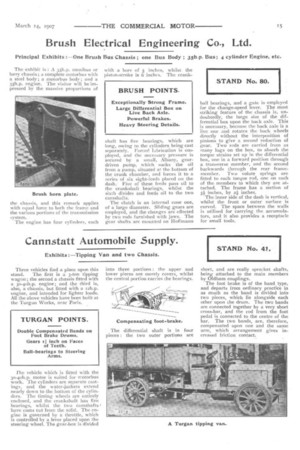Brush Electrical Engineering Co., Ltd.
Page 15

If you've noticed an error in this article please click here to report it so we can fix it.
Principal Exhibits: One Brush Bus Chassis ; one Bus Body ; 35h.p. Bus; 4 cylinder Engine, etc.
The exhibit is : A 35h.p. omnibus or lorry chassis; a complete motorbus with a steel body ; a motorbus body ; and a 35h.p. engine, The visitor will be impressed by the massive proportions of
the chassis, and this remark applies with equal force to both the frame and the various portions of the transmission system. • The engine has four cylinders, each with a bore of 5 inches, whilst the piston-stroke is 6 inches. The crank
shaft has five bearings, which are long, owing to the cylinders being cast separately. Forced lubrication is employed, and the necessary pressure is secured by a small, Albany, geardriven pump, which sucks the oil from a pump, situated at the bottom of the crank chamber, and forces it to a series of six sight-feeds placed on the dash. • Five of these feeds pass oil to the crankshaft bearings, whilst the sixth divides and feeds oil to the two camshafts.
The clutch is an internal cone one, Of a large diameter. Sliding gears are employed, and the changes are. effected by two rods furnished with jaws. The gear shafts arc mounted on Hoffmann
ball bearings, and a gate is employed for the change-speed lever. The most striking feature of the chassis is, undoubtedly, the large size of the differential box upon the back axle. This is necessary, because the back axle is a live one and rotates the back wheels directly without the interposition of pinions to give a second reduction of gear. Two rods are carried from as many lugs on the box, to absorb the torque strains set up in the differential box, one in a forward position through a transverse member, and the second backwards through the rear framemember. Two volute springs are fitted to each torque rod, one on each of the members to which they are attached. The frame has a section of 51 inches, by 2+, inches.
The inner side of the dash is vertical, whilst the front or outer surface is curved. The space between the walls is utilised for carrying the accumulators, and it also provides a receptacle for small tools.
































































